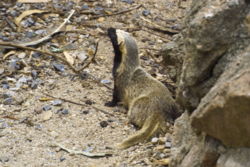Galictis
Grisons, also known as South American wolverines,[1] are mustelids native to Central and South America. The genus Galictis contains two extant species: the greater grison (Galictis vittata), which is found widely in South America, through Central America to southern Mexico; and the lesser grison (Galictis cuja), which is restricted to the southern half of South America. In Spanish it is referred to as a huroncito (literally "little ferret") or grisón and in Portuguese as a furão.[citation needed]
| Template:Taxobox name | |
|---|---|

| |
| Scientific classification | |
| Kingdom: | Animalia |
| Phylum: | Chordata |
| Class: | Mammalia |
| Order: | Carnivora |
| Family: | Mustelidae |
| Subfamily: | Mustelinae |
| Genus: | ''Galictis'' Bell, 1826 |
| Species | |

| |
| Galictis range | |
Grisons measure up to half a meter in length, and weigh between 1 and 3 kilograms. The lesser grison is slightly smaller than the greater grison. Grisons generally resemble a skunk, but with a smaller tail, shorter legs, wider neck, and more robust body. The pelage along the back is a frosted gray with black legs, throat, face, and belly. A sharp white stripe extends from the forehead to the back of the neck.
They are found in a wide range of habitats from semi-open shrub and woodland to low-elevation forests. They are generally terrestrial, burrowing and nesting in holes in fallen trees or rock crevices, often living underground. They are omnivorous, consuming fruit and small animals (including mammals). Little is known about grison behavior for multiple reasons, including the fact that their necks are so wide compared to their heads, an unusual difficulty that has made radio tracking problematic.[citation needed]
Evolution
editGrisons first appeared in South America during the early Pleistocene about 2.5 million years ago. They may be descended from the fossil genera Trigonictis and Sminthosinus, which lived in North America during the mid to late Pliocene.[2] There are at least three known fossil species, all of which were found in Argentina:[3]
- † Galictis hennigi
- † Galictis sanandresensis
- † Galictis sorgentinii
References
editThis article includes a list of references, but its sources remain unclear because it has insufficient inline citations. (November 2013) |
- ^ http://zipcodezoo.com/key/animalia/Mustelidae_Family.asp
- ^ Yensen, E. & Tarifa, T. (2003). "Galictis cuja". Mammalian Species: Number 728: pp. 1–8. doi:10.1644/728.
{{cite journal}}: CS1 maint: multiple names: authors list (link) - ^ Yensen, E. & Tarifa, T. (2003). "Galictis vittata". Mammalian Species: Number 727: pp. 1–8. doi:10.1644/727.
{{cite journal}}: CS1 maint: multiple names: authors list (link)
- Nowak, Ronald M. (2005). Walker's Carnivores of the World. Baltimore: Johns Hopkins Press ISBN 0-8018-8032-7